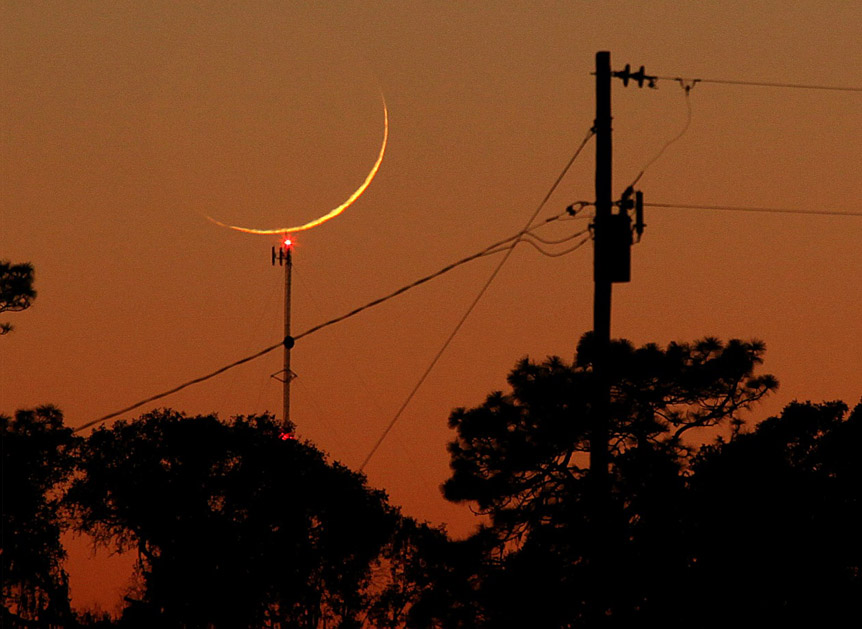Difference between revisions of "December 15, 2010"
| (3 intermediate revisions by the same user not shown) | |||
| Line 1: | Line 1: | ||
__NOTOC__ | __NOTOC__ | ||
=Lunar Calendar= | =Lunar Calendar= | ||
| + | <!-- Start of content --> | ||
<!-- ws:start:WikiTextHeadingRule:1:<h1> --> | <!-- ws:start:WikiTextHeadingRule:1:<h1> --> | ||
<!-- ws:start:WikiTextLocalImageRule:15:<img src="/file/view/LPOD-Dec15-10.jpg/188240961/LPOD-Dec15-10.jpg" alt="" title="" /> -->[[File:LPOD-Dec15-10.jpg|LPOD-Dec15-10.jpg]]<!-- ws:end:WikiTextLocalImageRule:15 --><br /> | <!-- ws:start:WikiTextLocalImageRule:15:<img src="/file/view/LPOD-Dec15-10.jpg/188240961/LPOD-Dec15-10.jpg" alt="" title="" /> -->[[File:LPOD-Dec15-10.jpg|LPOD-Dec15-10.jpg]]<!-- ws:end:WikiTextLocalImageRule:15 --><br /> | ||
| − | <em>image by [mailto:cohen@astro.ufl.edu | + | <em>image by [mailto:cohen@astro.ufl.edu Howard L. Cohen], Gainesville, Florida</em><br /> |
<br /> | <br /> | ||
| − | We dream of seeing a thin crescent in the sunset sky above a forest or perhaps the sea, but our real observing conditions often look more like this. No matter the foreground, observing young crescent Moons is serious business for those who wish to establish an Islamic calendar for Mecca. The simple ability to observe a young crescent allows the new Islamic month to begin in a calendar that depends on reliable witnesses who can attest that they have observed the new crescent Moon. A [http://www.meccacalendar.org/en/home.php | + | We dream of seeing a thin crescent in the sunset sky above a forest or perhaps the sea, but our real observing conditions often look more like this. No matter the foreground, observing young crescent Moons is serious business for those who wish to establish an Islamic calendar for Mecca. The simple ability to observe a young crescent allows the new Islamic month to begin in a calendar that depends on reliable witnesses who can attest that they have observed the new crescent Moon. A [http://www.meccacalendar.org/en/home.php Mecca Islamic Calendar] based on predicted visibility has been created. Even if the new crescent has not been observed in Mecca, observations of the crescent made within defined longitude zones west of Mecca can still establish the start of the new month and the time of morning prayers. This image of a 1.2 day Moon at an altitude of 1.9° from Gainesville, Florida is from a series of photographs taken to help verify predictions on zones of visibility for the Mecca Calendar. The first naked eye observation of this thin crescent exactly matched the prediction. Cold fronts moving into North Florida during the colder months often produce very clear skies that can make the Moon visible even at very low altitudes.<br /> |
<br /> | <br /> | ||
| − | <em>[mailto:cohen@astro.ufl.edu | + | <em>[mailto:cohen@astro.ufl.edu Howard L. Cohen]</em><br /> |
<br /> | <br /> | ||
<strong>Technical Details</strong><br /> | <strong>Technical Details</strong><br /> | ||
December 6, 2010, 11:15:32 UT, Canon EOS 5D Mark II ,Lens EF100-400mm f/4.5-5.6L IS USM set at 400mm, Exp. 0.7 sec at f/8, ISO 800, White Balance Daylight, cropped from original and slightly enhanced. Moon 1.2 days old with 1.7% illumination first sighted in 76-mm APO refractor 15 min. after sunset with first naked eye sighting 10 minutes later when Moon 5.5° high, an exact match to the Yallop algorithm.<br /> | December 6, 2010, 11:15:32 UT, Canon EOS 5D Mark II ,Lens EF100-400mm f/4.5-5.6L IS USM set at 400mm, Exp. 0.7 sec at f/8, ISO 800, White Balance Daylight, cropped from original and slightly enhanced. Moon 1.2 days old with 1.7% illumination first sighted in 76-mm APO refractor 15 min. after sunset with first naked eye sighting 10 minutes later when Moon 5.5° high, an exact match to the Yallop algorithm.<br /> | ||
<br /> | <br /> | ||
| + | <p><b>Yesterday's LPOD:</b> [[December 14, 2010|Moonman On Mars]] </p> | ||
| + | <p><b>Tomorrow's LPOD:</b> [[December 16, 2010|One Bird's Foot]] </p> | ||
<hr /> | <hr /> | ||
| − | + | <!-- Removed reference to store page 2 --> | |
| − | ---- | + | <!-- End of content --> |
| − | + | {{wiki/ArticleFooter}} | |
| − | |||
Latest revision as of 01:06, 9 February 2015
Lunar Calendar

image by Howard L. Cohen, Gainesville, Florida
We dream of seeing a thin crescent in the sunset sky above a forest or perhaps the sea, but our real observing conditions often look more like this. No matter the foreground, observing young crescent Moons is serious business for those who wish to establish an Islamic calendar for Mecca. The simple ability to observe a young crescent allows the new Islamic month to begin in a calendar that depends on reliable witnesses who can attest that they have observed the new crescent Moon. A Mecca Islamic Calendar based on predicted visibility has been created. Even if the new crescent has not been observed in Mecca, observations of the crescent made within defined longitude zones west of Mecca can still establish the start of the new month and the time of morning prayers. This image of a 1.2 day Moon at an altitude of 1.9° from Gainesville, Florida is from a series of photographs taken to help verify predictions on zones of visibility for the Mecca Calendar. The first naked eye observation of this thin crescent exactly matched the prediction. Cold fronts moving into North Florida during the colder months often produce very clear skies that can make the Moon visible even at very low altitudes.
Howard L. Cohen
Technical Details
December 6, 2010, 11:15:32 UT, Canon EOS 5D Mark II ,Lens EF100-400mm f/4.5-5.6L IS USM set at 400mm, Exp. 0.7 sec at f/8, ISO 800, White Balance Daylight, cropped from original and slightly enhanced. Moon 1.2 days old with 1.7% illumination first sighted in 76-mm APO refractor 15 min. after sunset with first naked eye sighting 10 minutes later when Moon 5.5° high, an exact match to the Yallop algorithm.
Yesterday's LPOD: Moonman On Mars
Tomorrow's LPOD: One Bird's Foot
COMMENTS?
Register, Log in, and join in the comments.



